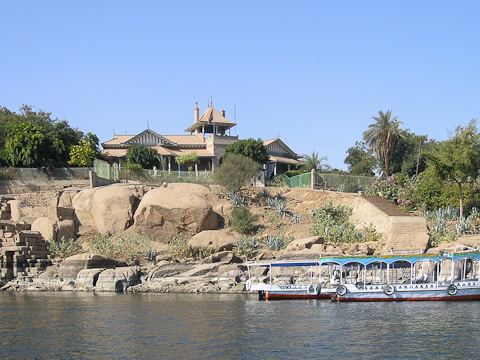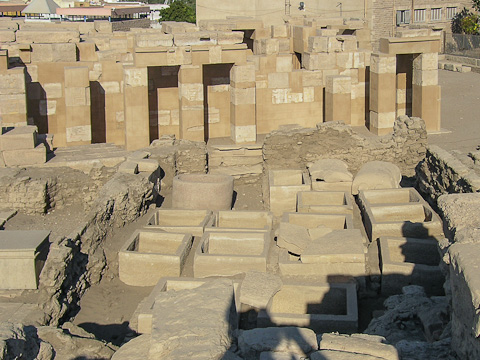Elephantine Island
Elephantine is an island in the centre of the Nile at Aswan. This was the original ‘border town’ between Egypt and the Nubian lands to the south and in ancient times was an important strategic position both for the defence of the border and as a trading route. The island has been inhabited from the Early Dynastic Period through Roman times until the present day. Its ancient name was ‘abu’ or ‘yebu’, which means elephant and was probably derived from the shape of the smooth grey boulders which surround the island, looking like elephants in the water.

Over the centuries there has been a great deal of building activity on Elephantine, though most of the ancient structures have now vanished. Excavations and reconstructions have been carried out over the past 100 years by teams of German archaeologists and the largest surviving structure today is the Temple of the ram-headed creator-god Khnum, at the southern end of the island, dating from New Kingdom to Roman times. A granite gateway built by Alexander is the only large structure of the temple which remains intact and the ruins behind it are difficult to identify due to ongoing excavation. At the front of the temple, which is oriented east to west, a restored pavement surrounds fragmentary remains of columns built by Rameses II. This leads down to a Roman quay.

There is little to be seen of the interior of the Temple of Khnum, but a large square granite gateway is one of the few surviving structures. During the past few excavation seasons the German-Swiss Mission to Elephantine, directed by C von Pilgrim, has been investigating the area around the New Kingdom remains of the Temple of Khnum. They have recently uncovered more of the plan of the temple – yielding details of the location of pylons, columned court and forecourt as well as a possible festival hall of Amenhotep II.

Further north, behind the museum building there is the site of a small restored Temple of Satis, the consort of Khnum, built in the time of Hatshepsut and Tuthmose III. The reconstruction by the German Archaeological Institute has been sensitively done, with the few reliefs supplemented by drawn elements. The temple was built over Middle Kingdom remains beneath different floor levels and also a Dynasty VI temple. The latest structure to emerge from the excavations at the Satis Temple is an Early Dynastic shrine which can be seen in a crypt-like area below the reconstructed temple, and this must be one of the earliest remaining temples in Egypt.

Probably one of the most interesting structures on the island, just in front of the museum, is the Nilometer. This was one of the earliest known nilometers and was used by the ancient Egyptians to measure the height of the Nile floods in order to forecast the level of inundation and so gauge taxes for the coming harvest. 90 steps lead steeply down to the river from the entrance. Along the banks of Elephantine there are many boulder inscriptions naming the kings and governors who have been associated with the island.

Other ancient sites on Elephantine
A First Intermediate Period palace area has been uncovered on Elephantine, which includes a large bakery, situated near the south-western harbour gate. This was constructed using high octagonal wooden columns, eight of these have been preserved and are among the earliest examples of such columns. The bakery, which was occupied over several phases, probably between Dynasties IV to XI, has been found to contain ovens and thousands of bread moulds. Ostraca containing distribution lists and mentioning the cult of Heqa-ib have also been found.
On the northern edge of the monumental area, behind the modern Nubian village, can be seen the remains of a small granite step pyramid, dated to Dynasty III, but its precise purpose is unknown. This is one of seven small mudbrick Old Kingdom pyramids which are spread throughout the Nile Valley from Aswan to Abu Rawash.

To the north of the Satis Temple there are mudbrick tombs of the sacred rams from the Late Period (the famous ram’s sarcophagus can now be seen in the Nubian Museum).

A cult shrine of Heqa-ib who was a deified governor of Elephantine in the Middle Kingdom can be seen to the west of the Satis Temple. His tomb can be seen among the nobles tombs on the West Bank of Aswan.
A chapel built by the Ptolemies, decorated for the Nubian King Arkemani and completed in later Roman times at Kalabsha Temple has been reconstructed on the southern end of the island.

The Aswan Museum, in an old resthouse at the entrance to the island is still open and has recently been extended and refurbished. The displays include mummies, weapons, pottery, utensils, and statues. Outside, a garden leads into the ruins of Abu, the pharaonic settlement on the island. Labels are in Arabic and English. The exhibits include some very interesting items from Elephantine which date right back to Predynastic times.
The northern end of the island is dominated by the Oberoi Hotel inside an enclosure and there are three modern Nubian villages.
How to get there
Elephantine Island can be reached by felucca from anywhere along the Corniche, or a motor boat from a landing near the telephone office. There is a private ferry which goes to the Oberoi Hotel but this lands inside the hotel enclosure.
